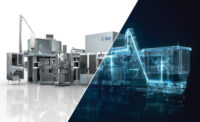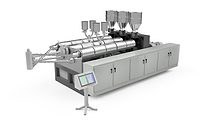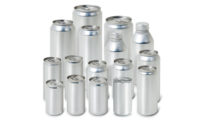New blow-molding equipment fulfills lightweight design for PET
Vision systems and gripping mechanisms more sophisticated

The earth’s carbon footprint not only is top of mind for consumers but also for packaging suppliers who are doing their part to reinvent plastic packaging, fulfill the premiumization expectations of the on-the-go consumer and push the boundaries of flexibility in plastic bottle manufacturing.
Along with the shift toward healthier, more natural beverages, the equipment and the raw materials used to produce said packaging matters more than ever before, says Raffaele Pace, vice president for equipment product management and digital solutions for Sidel, Octeville-Sur-Mer, France.
“Those products are ideally featuring an attractive and personalized packaging, promising a unique and fulfilling consumer experience, thus pushing the boundaries of flexibility in plastic bottles manufacturing,” Pace says. “With premiumization going hand in hand with downsizing format options and requiring more sophisticated and aesthetically pleasing bottle designs, commodity brands strive to be competitive and, accordingly, look for lighter bottles as well as more sustainable and flexible manufacturing processes, to save on raw material and resources while widening their product portfolio.
“Currently, not only civil society but also legislation is increasingly focused on sustainability concerns, which obviously create impacts on the way the industry is acting,” he continues. “At Sidel, we have always been working along the ideas of the circular economy. In our daily work, we strive to avoid all waste, minimize greenhouse gas emissions, cut water and energy consumption and promote recyclability.”
Taking its commitment a step further, Sidel recently joined the New Plastics Economy Global Commitment, a worldwide initiative launched by the Ellen MacArthur Foundation and UN Environment with the goal of addressing the plastic waste and pollution crisis at its source and keeping plastics within the economy. The foundation unites more than 400 organizations on its common vision of a circular economy for plastics, Pace adds.
Because health and wellness remains a global trend and with an aging population, emphasis is being placed on increased vitamin and nutrient content, as well as smaller packages with less sugar content, notes Henry Zhang, director of marketing and market intelligence for Husky Injection Molding Systems.
Zhang suggests that these types of packages require better protection for sensitive content, which is provided by Husky’s Multi-Layer Technology. Zhang explains that this technology protects sensitive beverages, allows for new and innovative package designs, and provides maximum shelf differentiation.
At K2019 in Dusseldorf, Germany, the Bolton, Ontario-based company debuted its versatile HyPET5 PET systems portfolio as well as its flexible, lower cavitation NexPET system and mold. The company also offers a HyPET HPP5e system designed to deliver complete design freedom, energy savings, system reliability, superior preform quality and user friendliness, it says.
“Our new HyPET family platform and NexPET mold address the need for both high-volume and mid-volume production, providing flexibility and the ability to quickly respond to market demands,” Zhang says. “… We also provide complete manufacturing solutions for bottle preform production through our HyPET platform; for closures through our HyCAP platform; and for other packaging applications, including specialty closures and thinwall, through our HyperSync/Hylectric platform.”
Reinventing a circular economy
Although experts note that recyclability of beverage containers is important, Jon Larson, head of technical sales for plastics at Franklin, Wis.-based Krones, thinks the beverage industry is in a “state of confusion” over what used to be the gold standard: recycled content.
“Consumers and supply chains are asking for alternatives to single-serve plastic containers. Recycled content once the gold standard is not considered a good enough alternative,” he explains. “Brand owners are exploring options in aluminum, carton and biodegradable resins. None of the alternatives are a better environmental option but emotions are dictating the conversation, not facts.
“Traditional plastic packaging companies must make hard decisions on where to invest their capital. Is it to abandon plastics and invest in new equipment for alternatives? Or do they wait out the storm, hedging their bets that this will blow over?,” Larson continues. “Our vision isn’t to reinvent plastic but [to] reinvent how a circular economy for plastics should work.”
Arne Wiese, product manager of bottles and shapes for KHS Group, also is seeing uncertainty. “They have made their environmental studies to find out consumers consider a different container type and material to be environmentally preferable,” he explains. “So what way to go? All players in the market have understood that collecting and closed-loop recycling is the way to go to make a good product even better.”
Based in Hamburg, Germany, KHS developed the first commercial bottle with 100 percent rPET (recycled PET) as part of its Bottles & Shapes program, which already has yielded state-of-the-art stretch blow molding technology and experience gleaned from more than 4,000 developed container designs, Wiese explains.
Wiese hopes that rPET, an alternative material to virgin PET, will serve as a model for other beverage producers.
“The recyclate PET bottle is a totally new development, into which much thought has gone: start-up share’s concept dictates that for each product purchased a further product be donated to people in need,” Wiese says. “Furthermore, the sale of the new bottle in 2019 aims to save over 200 metric tons of plastic waste. It aims to do so by only processing recycled PET or rPET to produce new, high-quality bottles.”
In fact, the bottle-making process with the sole use of recyclate is not as challenging because the material is dark in color, making the preforms easier to heat and thus even simpler to make than PET bottles with virgin material, according to Wiese.
The supply chain and PET
Sustainability remains at the forefront of plastic bottle manufacturing and companies are striving to impart a holistic, end-to-end approach.
Sidel’s Pace notes that the company studies its packaging and equipment with a 360-degree perspective tied to primary, secondary and tertiary packaging and their interaction with plant equipment.
“[W]hen evaluating the environmental footprint of packaging solution options such as PET, [high-density polyethylene] (HDPE), glass or can, you must take a holistic approach,” Pace says. “Technically and industrially PET, cans and glass can all be recycled.
“… As PET can be brought back into the value chain, it shouldn’t be considered as a fundament of the problem. In fact, due to its unique properties in terms of food safety, convenience, design flexibility, transparency and especially closed-loop recyclability, approximately 37 percent of beverage volume is packaged in PET,” he continues, citing Chicago-based Euromonitor International.
A new packaging solution, X-Lite Still is compatible with rPET, as long as the quality of the material is appropriate. For example, based on Sidel’s blow molding tests, X-Lite Still can contain between 25 percent and 50 percent of rPET while ensuring the bottle’s quality and performance.
Serving non-carbonated water producers, X-Lite Still, weighing 6.5 grams for a 500-ml format, is “the world’s lightest industrial bottle for this industry,” Pace says. “It also can withstand the challenges placed by very high speed outputs and is the most cost-effective and sustainable packaging solution.”
Another packaging/recyclable solution comes courtesy of the Krones MetaPure Plastics Recycling product line, a state-of-the-art technology that enables post-consumer plastics to be processed to EU and FDA standards for reuse in food packaging, Larson says.
The first to integrate recycling with packaging manufacturing under one roof, Krones is focused on minimal process steps, energy conservation and quality control from end to end, resulting in the creation of new plastic packaging with the lowest possible carbon footprint, Larson says.
To tackle and increase plastics’ sustainability, Krones recently introduced the Contiform 3 Speed rotary blowmolder, which can be equipped with eight to 36 blowing stations and achieve an output of as many as 82,500 bottles an hour. In addition, customers can block the Contiform blowmolder to a filler and labeler to create a production line that maximizes efficiency and minimizes floor space.
The evolution of packaging equipment
Packaging equipment — and the types of plastic bottles they produce — have evolved. Dating back to the 1970s, Sidel’s first blow molding machines were running at 360 bottles an hour for each mold, while today’s equipment is running at 2,700 bottles an hour for mold, 7.5 times faster, Pace notes.
Pace highlights a few of the company newest machines. The Sidel Super Combi is a smart solution serving the water and carbonated soft drinks (CSD) market that can run as fast as 91,800 bottles an hour. The Aseptic Combi Predis aseptically bottles liquid dairy products (LDPs), CSDs, juices and teas using a patented aseptic blow-fill-seal solution with dry preform sterilization taking place during the preform phase instead of the bottle phase. The BoostPRIME was developed for hot-filling juices, teas, isotonics and LDP in PET, while improving lightweighting opportunities as bottles are as much as 30 percent lighter than regular PET alternatives.
KHS’ Wiese notes that machines have become more environmentally friendly with less energy consumption per manufactured bottles as well as higher output rates per cavity resulting in optimized performance. “Futhermore, the trend is to block machine,” he adds.
In the future, Husky Injection Molding System’s Zhang predicts that more digital-based machines with faster responses to market needs will become increasingly important. As will marketing and packaging design.
“With more packages than ever before on the shelf, bottle manufacturers need to design packages that stand out in the minds of consumers,” Zhang says. “With a variety of closure types, application expertise and our Multi-Layer technology, we can enable more never-before-seen sizes, shapes, colors and gradients to ensure maximum shelf differentiation.”
Husky’s President and Chief Executive Officer John Galt adds: “Consumer trends are dynamic due to increasing urbanization, health and wellness consciousness and a new, younger generation of shoppers focused on digital experiences and sustainable choices. By working with our customers, partners and suppliers around the globe, we are able to develop integrated manufacturing solutions that support our customers’ growth initiatives.” BI
Looking for a reprint of this article?
From high-res PDFs to custom plaques, order your copy today!






